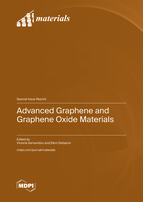Advanced Graphene and Graphene Oxide Materials
A special issue of Materials (ISSN 1996-1944). This special issue belongs to the section "Carbon Materials".
Deadline for manuscript submissions: closed (10 December 2023) | Viewed by 34349
Special Issue Editors
Interests: analytical chemistry; sample preparation; chromatography; HPLC; method validation; method development; separation science; food analysis; bioanalysis; environmental analysis; green analytical chemistry; sorptive extraction; microextraction techniques
Special Issues, Collections and Topics in MDPI journals
Interests: materials chemistry; materials characterization; nanomaterials; graphene oxide; activated carbon; wastewater treatment; separation; adsorption; catalytic oxidation; environmental applications
Special Issues, Collections and Topics in MDPI journals
Special Issue Information
Dear Colleagues,
Graphene and graphene oxide are widely applied as successful sorbent materials for various compounds obtained from biosamples and surface water samples. Therefore, they are suitable for future use in numerous biomedical and environmental applications.
Moreover, their functionalization with magnetic nanoparticles can lead to magnetic sorbents, thus allowing convenient sample treatment via magnetic separation.
To date, a plethora of graphene and graphene oxide materials have been synthesized and successfully employed for solid-phase extraction of organic compounds from environmental and biological samples. The unique properties of these materials enrich the analytical toolbox available for the analysis of various organic compounds in various matrices and make them precise and valuable means for handling analytical and environmental issues.
This Special Issue is supported by the Sample Preparation Study Group and Network, supported by the Division of Analytical Chemistry of the European Chemical Society.
Prof. Dr. Victoria Samanidou
Prof. Dr. Eleni Deliyanni
Guest Editors
Manuscript Submission Information
Manuscripts should be submitted online at www.mdpi.com by registering and logging in to this website. Once you are registered, click here to go to the submission form. Manuscripts can be submitted until the deadline. All submissions that pass pre-check are peer-reviewed. Accepted papers will be published continuously in the journal (as soon as accepted) and will be listed together on the special issue website. Research articles, review articles as well as short communications are invited. For planned papers, a title and short abstract (about 100 words) can be sent to the Editorial Office for announcement on this website.
Submitted manuscripts should not have been published previously, nor be under consideration for publication elsewhere (except conference proceedings papers). All manuscripts are thoroughly refereed through a single-blind peer-review process. A guide for authors and other relevant information for submission of manuscripts is available on the Instructions for Authors page. Materials is an international peer-reviewed open access semimonthly journal published by MDPI.
Please visit the Instructions for Authors page before submitting a manuscript. The Article Processing Charge (APC) for publication in this open access journal is 2600 CHF (Swiss Francs). Submitted papers should be well formatted and use good English. Authors may use MDPI's English editing service prior to publication or during author revisions.
Keywords
- Graphene oxide
- Graphene
- Solid-phase extraction
- Microextraction
- Green chemistry
- Sample preparation
- Clean-up
- Nanomaterials
- Magnetic solid-phase extraction
- Dispersive solid-phase extraction
- Magnetic sorbents
- Biomedical applications
- Environmental applications








